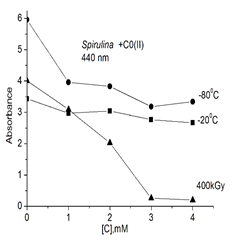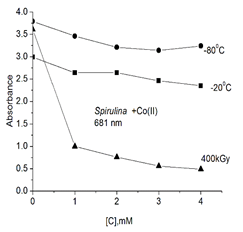International Journal of
eISSN: 2574-8084


Research Article Volume 11 Issue 1
Iv. Javakhishvili Tbilisi State University E. Andronikashvili Institute of Physics, Georgia
Correspondence: Eteri Gelagutashvili, Iv. Javakhishvili Tbilisi State University, E. Andronikashvili Institute of Physics, 0177, 6,Tamarashvili St., Tbilisi, Georgia
Received: March 13, 2024 | Published: March 25, 2024
Citation: Gelagutashvili ES, Bagdavadze NV. Effect of Co(II) ions on frozen at -800C and -200C and with Cs137 irradiated Spirulina after cultivation. Int J Radiol Radiat Ther. 2024;11(1):19-22. DOI: 10.15406/ijrrt.2024.11.00379
Influence of Co(II) ions on frozen at -800C and -200C temperature and high dose irradiated Cs137 (400kGy) and then recultivated on spirulina , when after cultivation all samples were placed in 40C temperature during three weeks were studied using UV–Visible spectrometer. The absorption processes was relatively fast in the small concentrations for Co(II) in the case of interaction with irradiated spirulina, but for frozen spirulina absorption decrease was regarded very slow.
It was shown, that effect of Co(II) ions on spirulina constituents ((Chlorophyll a, phycocyanin, carotenoids) at various conditions are different.
Keywords: Spirulina, Co(II) ions
Blue-green algae (cyanobacteria) spirulina, is an alternative source of protein for human food and feed purposes. It involves polysaccharides, lipids, and vitamins.1,2 Currently, spirulina is commercialized and sold for therapeutic purposes. It has immune protective, anti-diabetic, antiviral, etc. properties, has the ability to dramatically reduce the chance of developing cancer, heart disease or stroke. Spirulina is known to ameliorate organ toxicity caused by heavy metals.
Some studies have shown that conventional drying systems may be ineffective in preserving the nutritional quality of microalgae. Therefore, alternative methods that better preserve its functional and nutritional properties, especially the content of bioactive compounds, should be considered and evaluated.3,4 In works5,6 was shown that all sample versions of spirulina is radioresistant, when the algae is irradiated with high doses of Cs137 gamma irradiation. Therefore, the use of high dose of radiation can be an interesting alternative for processing spirulina biomass due to its advantages over other conventional methods. In cyanobacteria, metals are exerting toxic action mostly by damaging chloroplast and disturbing photosynthesis.7 In works8,9 effect of toxic metal ions Cd(II) and Pb(II) on spirulina intact cells have been studied with optical and differential scanning microcalorimetry (DSC) methods after 7.2 kGy 137Cs gamma irradiation and without irradiation.8 It was shown that the addition of metal ions causes a decrease in optical absorption spectra band intensities. In the case of irradiation, the absorption band intensity decreases higher than without irradiation. In work10 effect high dose of Cs137 and Co(II), Cd(II), Ag(I) ions on spirulina after cultivation was study. It was shown that possible use of a high dose of gamma irradiation does not change the nature of the interaction of these metal ions for intact cells spirulina and its constituents. Although consumption of spirulina is increasing worldwide, relatively few studies have reported the potential health effects of heavy metals in populations across different settings on spirulina.
In this work, using UV-visible spectrometry were studied the effect of Co(II) ions on those frozen at -800C and -200C and irradiated with high doses (400kGy) of Cs137, and then re-cultivated on spirulina. In contrast to the studies in work,10 where Co(II) effects on spirulina were performed immediately after removal of high-dose irradiation and subsequent 2-week cultivation, in this work, after irradiation and after 2-week cultivation spirulina were placed on temperature 40C and influence Co(II) ions on spirulina was studied after 3 weeks. Similar conditions were considered for frozen cases.
Spirulina IPPAS B–256 strain was cultivated in a standard Zarrouk11 alkaline water–salt medium at 34ºС, illumination ∼5000lux, at constant mixing in batch cultures.12 The cultivation of the spirulina intact cells was conducted for 7 days. The growth was measured by optical density by monitoring of changes in absorption at wavelength 560 nm using the UV–Visible spectrometer Cintra 10e. Spirulina grows optimally in pH range of 9-11.
The intact cells suspension of spirulina at pH 10.1 in the nutrition medium was used for scanning the absorption spectra from 400 to 800 nm. The concentration of spirulina was determined by the instrumental data. Spirulina suspension (100 ml) after 7 days of cultivation have been irradiated with 400 kGy gamma radiation using Cs137 as a gamma radiation source at the Applied Research Center, E. Andronikashvili Institute of Physics (Dose rate -1.1Gy during one minute). By analogue after 7 days of cultivation spirulina was frozen at -200C in first case and -800 C in other case during 48 hours and then suspension after the irradiation (400 kGy) and frozen were filled up with Zarrouk medium and they were recultivated during 14 days. Melting of frozen spirulina was performed by step wise at -20°C, 4°C, 23°C, and -80°C, 4°C, 23°C. After cultivation samples were placed in 40C temperature during three weeks, as in the case after irradiation. The solutions of metal ions were prepared in deionized water with appropriate amounts of inorganic salt.
Influence of Co(II) ions on frozen at -800C and -200C and high dose irradiated Cs137 and then recultivated on spirulina were studied as a function of metal concentration. Fig.1 shows the absorption characteristics after irradiation, frozen and re-cultivation of cells spirulina. The peak at 681 nm is due to the absorption of Chl a peak. At 621 nm is due to the absorption of phycocyanin (PC). At 500 nm is due to the absorption of carotenoides. A peak at 440 nm is due to soret band of Chl a.13 In Figure 1 (A, B,C) are shown effect of Co(II) ions on the absorption of the irradiation (400kGy), frozen at -800C and -200C temperatures and thawed and after that re-cultivation cells of spirulina. (It is seen from Figure 1), that with increasing metal concentrations absorption intensity decreased for all cases. As can be seen from this figure 1-5, the uptake processes were relatively fast at low concentrations of Co(II) in the case of interaction with irradiated spirulina, but for frozen spirulina the effect is considered to be very slow. In this case, when irradiated spirulina was placed at 40°C for 3 weeks after 2 weeks of cultivation, there was no difference in the effect of Co(II) interaction on irradiated spirulina after cultivation and immediately measurements.10

Figure 1 Absorption spectra of spirulina after frozen at -800C , at -200C, at irradiated and re-cultivation-(1) + Co(II) ions (2-5). 1→5 [Co(II)]=0 ÷5 mM; (after 2-week cultivation in all cases spirulina were placed on temperature 40C during three weeks).

Figure 2 Influence of Co(II) ions after irradiation (400kGy) and after frozen -200C and -800C on temperature and then re-cultivation of spirulina (changes in the soret band of Chl a (440nm)).

Figure 3 Influence of Co(II) ions after irradiation (400kGy) and after frozen -200C and -800C on temperature and then re-cultivation of spirulina (changes in the carotenoids(500nm).

Figure 4 Influence of Co(II) ions after irradiation (400kGy) and after frozen -200C and -800C on temperature and then re-cultivation of spirulina (changes in the basic protein -the phycocyanin(621nm)).

Figure 5 Influence of Co(II) ions after irradiation (400kGy) and after frozen -200C and -800C on temperature and then re-cultivation of spirulina (changes to the constituent- chlorophyll a(681nm)).
Influence of Co(II) ions after irradiation (400kGy) and after frozen -200C and -800C on temperature and then re-cultivation of spirulina constituents (Chl a, PC, carotenoids) are shown in fig.2-5. It is clear, that effect of Co(II) ions on the absorption intensity maximums for wavelength 440nm, 500 nm, 621 nm and 681nm of spirulina constituents are different. In particular, at 440 nm (changes to the constituent- soret band into the chlorophyll a) with increasing Co(II) concentration the intensity of absorption decrease at high dose of radiation, decreases less after frozen -800C , but almost does not change for the case -200C on temperature. As for the change in absorption intensity at 621 nm, which is the peak of absorption of the major protein-phycocyanin of spirulina, the absorption intensity very efficiently decreases at high dose of radiation, but almost does not change for the case after frozen -200C and -800C on temperature. Analogue results were received for carotenoids at 500 nm wavelength and for the chlorophyll a at 681nm wavelength.
If we compare the results obtained after irradiation with the results obtained in our work,10 we can see that a three weeks delay at 40C temperatures of spirulina did not affect the influence of Co(II) on spirulina. In14 reported that the viability of marine unicellular algae under cryopreservation did not correlate to the age of culture, but related to the size and specific growth rate. Using the optical and DSC studies, it was shown that spirulina irradiated with Cs137 γ 400 kGy and then stored under anaerobic conditions in dark at 4 ◦C remained viable despite 96.9 % denaturation of its whole biomass.5,6 The DSC data showed that PBSc in the recultivated samples, which were preliminarily irradiated with 10–400 kGy doses, melted cooperatively.5,6 The high subzero preservation of spirulina CMU2 and spirulina GD1 was performed by step wise freezing at 25, 4, and -20°C for 30 min. Then they were preserved at -80°C for seven months with four cryoprotectants: dimethyl sulfoxide, horse serum, calf serum and glycerol.15 The studies on equilibrium isotherm experiments showed highest maximum metal loading by living cells (181.0 mg Co(II)/g16 followed by lyophilized (79.7 mg Co(II)/g and oven-dried (25.9 mg Co(II)/g, biomass of spirulina on a dry weight basis. Spirulina contain a variety of functional groups such as carboxyl, hydroxyl, sulphate and other charged groups which are responsible for metal binding.16 The employment of this blue-green alga to uptake heavy metals in contaminated sites has been explored.17 Recent studies have shown that spirulina can be used for treating wastewater, including effluent from fish culture activities, as it can efficiently metabolize the nutrients and remove the heavy metals contained in aquaculture effluent.18 In work19 provides insight into the potential of algal biomass as agricultural fertilizers, when coupled with aquaculture wastewater remediation.
Thus, based on our results, it can be assumed that a large dose of radiation and freezing at different temperatures does not affect the viability of spirulina and, despite extreme changes in external conditions, can also interact with Co(II) ions as without these conditions.
None.
Authors declare no conflict of interest.

©2024 Gelagutashvili, et al. This is an open access article distributed under the terms of the, which permits unrestricted use, distribution, and build upon your work non-commercially.